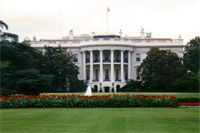 The White House Thursday told aviation officials to reduce congestion and delays, or at least not repeat what the first seven months of 2007 have been — the most delayed air travel season on record. The Bureau of Transportation Statistics attributes responsibility for the delays equally between the national airspace system and the airlines (each winning 28 percent responsibility) with 38 percent attributed to rippling effects. Only 6 percent of delays could be attributed to weather, according to the Bureau. The push will bring even more tension to an already charged battle for space fought between airlines, private jets and the interests of the air traffic controllers union. President Bush’s specific guidance was to ask Transportation Secretary Mary Peters to consult with those in the aviation industry who would help create a strategy by year-end with solutions to be implemented next year.
The White House Thursday told aviation officials to reduce congestion and delays, or at least not repeat what the first seven months of 2007 have been — the most delayed air travel season on record. The Bureau of Transportation Statistics attributes responsibility for the delays equally between the national airspace system and the airlines (each winning 28 percent responsibility) with 38 percent attributed to rippling effects. Only 6 percent of delays could be attributed to weather, according to the Bureau. The push will bring even more tension to an already charged battle for space fought between airlines, private jets and the interests of the air traffic controllers union. President Bush’s specific guidance was to ask Transportation Secretary Mary Peters to consult with those in the aviation industry who would help create a strategy by year-end with solutions to be implemented next year.
For her part, Peters immediately pointed a finger toward the Northeast, where she says New York’s airspace accounts for some three-quarters of all chronic airline delays. The FAA is currently working on a new system of flight patterns it hopes will cut delays in the Northeast by 20 percent. But Peters has indicated that congestion pricing, tighter slot limits, and efforts even less favored by the industry may be coming if it fails to work with her to meet the presidential mandate. The industry is rarely happy to cut back scheduling of packed aircraft for the sake of reducing congestion and during a recent House subcommittee hearing Air Transport Association President James May said “Congress should resist calls to force airlines to reduce flights or impose economic measures to curb passenger demand simply because this approach is expedient.”


































